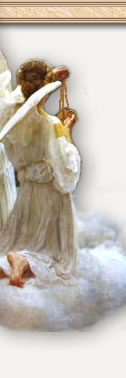




 |
|

|
|
|||||||||||
|
|
|
|
||||||||||||
 |
|
|
||||||||||||
 |
|
 |
|
|||||||||||
|
|
||||||||||||||
 |
 |
|
|
|
|
Rumbles from France A recent article in the French-language journal of the Fraternity of Saint Peter has grave implications for the effort to regularize the Society of Saint Pius X An article recently published in the French-language theological journal of the Priestly Fraternity of Saint Peter contends, in essence, that all the priests and bishops of the Society of Saint Pius X (SSPX) are non-Catholic ministers whose ministrations Catholics should avoid under pain of sin. This claim goes well beyond any official Vatican pronouncement on the status of SSPX clergy and lay adherents. The Letter
and the Heart of the Law Thus, Mons. Lefebvre and the four priests he consecrated bishops, but only these five, were declared to have been excommunicated latae sententiae as envisioned in canon 1382—that is, automatically by their own act, rather than by a sentence following a canonical process.1 These five clerics—but, again, only they—were also declared to have committed the offense of schism as envisioned in canon 751, even though neither canon 1382 nor the canonical warning issued to Archbishop Lefebvre before the consecrations states that an illicit episcopal consecration constitutes a schismatic act. Adhering strictly to the letter of the motu proprio, various detractors of the SSPX declare the case closed. But it has never been that simple. For one thing, the Church is not constrained by the letter of her own law when justice or charity would indicate a different course. Indeed, given that the Vatican has effectively ceased applying the term schismatic to the Orthodox or even to the one hundred illicitly consecrated bishops of the communist-controlled Catholic Patriotic Association (CPA) in China, it would hardly be commensurate with justice or charity to treat SSPX adherents as rank schismatics, cast into outer darkness, and leave it at that. This is all the more so when one considers that the actions of Catholics with respect to Church law are not judged by the legal standards applicable to such civil matters as traffic tickets or insider trading. Unlike civil law, Church law explicitly recognizes an excuse from the operation of penalties where subjective culpability can be shown to be lacking, just as God Himself would excuse an objectively wrongful action absent subjective guilt. Even a penalty of excommunication imposed in the external forum arguably does not operate where the offender has acted out of what he believed in conscience to be grave necessity or to avoid grave inconvenience. Cf. canons 1321, 1323. Where schism is concerned, there must be a subjective intention to refuse communion with the Roman Pontiff, not merely a single act of disobedience to a particular command (in this case the command that a papal mandate is required for consecration of bishops). Moreover, there has never been any clear determination of the status of the priests and lay adherents of the SSPX who are not the subject of the penalties declared in the motu proprio. While the motu proprio speaks of “formal adherence to the schism” as grounds for incurring the same penalties as the five, the term “formal adherence” has never been defined in any universally binding pronouncement by a competent Vatican dicastery, which would appear to be either the Congregation for the Doctrine of the Faith or the Ecclesia Dei Commission. None of these observations is meant to suggest that the 1988 motu proprio may be disregarded. Rather, they are offered to suggest why, on the practical or existential level, not even certain Vatican officials who have had care of the SSPX affair have treated it as a case of true and proper schism. Despite the strict letter of the motu proprio, these officials have tended to view the SSPX as inhabiting a kind of canonical gray area involving Catholics in an irregular situation. There are many indications of this attitude in Vatican-level statements. Let us consider several examples: • In La Repubblica, October 7, 1988, Cardinal Castillo Lara, President of the Pontifical Council for the Interpretation of Legislative Texts, conceded that under the terms of canon 1382, “The act of consecrating a bishop (without the agreement of the Pope) is not in itself a schismatic act…” since the only penalty imposed by the canon is excommunication latae sententiae. The Cardinal went on to assert that the SSPX schism had arisen before the 1988 consecrations, but that argument is without canonical foundation since no Vatican document even suggested the SSPX was schismatic before the consecrations. If, as Cardinal Lara admits, the consecrations standing alone did not produce a schism, then of course the whole question of schism becomes debatable. (I do not take up that debate here.) • On May 3, 1994, Edward Cardinal Cassidy, President of the Pontifical Council for Christian Unity, issued a letter stating that “The situation of the members of this Society [SSPX] is an internal matter of the Catholic Church. The Society is not another Church or Ecclesial Community within the meaning used in the Directory [on Ecumenism]….” The status of the SSPX could hardly be an internal Church matter if its adherents were in a state of true and proper schism. • On June 3, 1993, the Congregation for the Doctrine of the Faith, in a decision signed by Cardinal Ratzinger, declared that attendance at an independent chapel in Honolulu staffed by SSPX priests, and even the reception of the Sacrament of Confirmation from an SSPX bishop at this chapel, were:
• On September 28, 1999 (under Protocol N.539/99), Monsignor Perl of the Ecclesia Dei Commission replied as follows to an inquiry about whether one incurred the delict of schism by attending Mass each Sunday at an SSPX chapel in Arizona:
Here an ambivalent view of the SSPX is plainly evident: its priests are deemed suspended—a penalty they could hardly incur if they were true and proper schismatics, since non-Catholics are not subject to Church disciplinary law. SSPX priests are deemed schismatic only if they “formally adhere” to the schism, a term which has yet to be defined. Attendance at an SSPX chapel (in the liturgical wasteland of Arizona) is not encouraged, but neither is it forbidden. On the contrary, it is conceded that there is no penalty whatever for attending Mass at SSPX chapels if one does so “because of the reverence and devotion which they find there, because of their attraction to the traditional Latin Mass and not because they refuse submission to the Roman Pontiff.” Monsignor Perl would hardly give such advice if the SSPX were a strictly schismatic association. Even more important evidence in this regard is the letter of Cardinal Dario Castrillon Hoyos, dated April 2, 2002, to Bishop Bernard Fellay of the SSPX. The letter takes the SSPX to task for certain provocative statements in its publications and the current standstill in negotiations for its regularization. (Those negotiations had begun in the summer of 2000 with Cardinal Castrillon Hoyos’ letters to all the SSPX bishops, addressing each as “dear Brother.”) While the letter speaks of restoring “full communion” with SSPX bishops, it clearly views them as Catholic prelates whose situation is irregular, rather than strictly schismatic. Note the fraternal tone of the April 2nd letter and the forms of address employed (“Your Excellency,” “Excellencies,” “Monsignors,” “brother”, etc.):
The Cardinal’s letter and the other statements quoted reflect a situation whose concrete circumstances do not fit neatly into existing canonical categories. The Cardinal, for one, clearly views the situation of the SSPX the same way he viewed the recently regularized extra-diocesan traditionalist outpost in Campos, Brazil, whose shepherd, Bishop Rangel, was one of those consecrated by Archbishop Lefebvre in 1988. In fact, the Cardinal refers explicitly to the SSPX’s “irregular situation” and charitably concedes that in his meeting with the SSPX bishops “there was not disclosed any inkling of heresy nor any will to incur a formal schism.”2 This is what the SSPX has maintained all along, and what the Catholics of Campos had maintained before their regularization. Just as in the case of Campos, it is a question of regularizing the canonical status of a group of Roman Catholic traditionalists who would not have to abjure any formal schism (because none exists), nor any doctrinal error, but rather would retain, without the least modification, their “own charism of service to Tradition”—which is to say, the beliefs and practices of every Roman Catholic before the unprecedented changes ushered in by Vatican II. In short, the letter of the law notwithstanding, the living reality of the SSPX affair is that of an internal wound in the visible commonwealth of the Church resulting from the unprecedented postconciliar upheavals, as opposed to ending a true and proper schism like that of the Orthodox or the Old Catholics. As the Cardinal’s letter notes, regularization of the SSPX has become a prime concern of Pope John Paul II himself in the waning days of his pontificate. The Cardinal’s conciliatory approach may well be a reflection of that papal concern. Indeed, the recent Vatican approaches to the SSPX constitute a marked departure from the strange double standard which consigns the SSPX to oblivion while an earnest ecumenical courtship is pursued with militantly anti-Roman Orthodox bishops, and even communist-controlled CPA bishops handpicked by the bloody Jiang regime—which brutally persecutes the “underground” bishops, priests and laity who remain loyal to Rome. To his credit, Cardinal Castrillon Hoyos has recognized that this double standard is untenable. The French
Development Unlike Cardinal Castrillon Hoyos or Monsignor Perl, Father de Montjoye unhesitatingly declares that all the priests as well as the bishops of the SSPX are both excommunicated and schismatic—a sentence the Vatican has never pronounced. Father de Montjoye further opines that SSPX clerics, both bishops and priests, are not even Catholics. He even goes so far as to claim that reception of Communion from an SSPX priest does violence to the sacrament, injures the Church, and transgresses divine law: [T]o receive the sacraments from a non-Catholic minister—which is to say, one who is not in full communion with the Church, which is the case with the Society of Saint Pius X—is an injury to the Church, an offense to God and to the plan he [sic] established in the world. To communicate [receive Holy Communion] at a Mass celebrated by a schismatic priest, outside of the extreme cases where the Church authorizes it, is to do violence to the sacrament.… A non-Catholic minister does violence to the sacrament of the Eucharist in consecrating outside the communion of the Church…. They [our ancestors] were in horror of receiving communion from the hand of a schismatic. [T]o receive the sacraments from non-Catholic ministers (which is the case with priests attached to the Society of Saint Pius X) it is necessary to fulfill the conditions fixed by the supreme authority and specified in the Code of Canon Law.… Note well that the enunciated conditions for exceptional cases where one can receive sacraments administered by non-Catholic ministers are cumulative conditions…. To accept a certain indifferentism and to communicate [receive Communion] from a priest of the Society of Saint Pius X thus places us in rebellion against divine law. The last three quotations pertain to Father de Montjoye’s argument concerning canon 844, § 2, which allows Catholics to receive the sacraments of confession, Communion and extreme unction from Orthodox and other non-Catholic clerics with valid holy orders “whenever necessity requires or a genuine spiritual advantage suggests it,” provided that “the danger of error or indifferentism is avoided.” Contrary to the advice given by Monsignor Perl in Protocol 539/99, and contrary to the view of Cardinal Castrillon Hoyos that the SSPX “was not disseminating any heresy, nor nurturing schismatic attitudes,” Father de Montjoye opines that canon 844 does not permit the reception of the sacraments from an SSPX priest or bishop because of “the danger of indifferentism.” In other words, according to Father de Montjoye, SSPX clergy practice a non-Catholic religion. He concludes that, at most, one may passively “assist but not communicate” at SSPX Masses for a grave reason (e.g. a funeral), and that to communicate at such Masses is a “case of active participation (communicatio in sacris)” in non-Catholic worship, which divine law forbids. Without at all defending canon 844 as a prudent disciplinary measure, it must be said that by construing it as he does Father de Montjoye effectively places SSPX clergy at a farther remove from the Catholic Church than the Orthodox, the Old Catholics and even the illicitly consecrated episcopal puppets of the Jiang regime! By what right does he do so, when no Vatican pronouncement binds the faithful to such a view? Of course, the Church has always taught that schismatics do violence to the sacrament of Holy Communion when they confect it, and that communicatio in sacris with non-Catholics is contrary to divine law. One indeed wishes that these theological truths had not been consigned to practical oblivion in the course of the post-conciliar “ecumenical venture.” What is disturbing here is not that Father de Montjoye has presented the Church’s traditional teaching, but rather that the teaching is being revived solely for the purpose of denouncing a society of priests and bishops whom Cardinal Castrillon Hoyos rightly addresses as Catholics, despite their “irregular situation.” How does this exercise assist the Cardinal in his effort to regularize the SSPX at such a crucial point in its dialogue with the Vatican? What does the Church gain from yet another denunciation of the SSPX at the same time both Protestants and Orthodox of every stripe are being treated as “brothers in the Lord” and invited to participate in joint liturgical ceremonies with Catholic prelates, including the Pope himself, without the least mention of the evil of schism or communicatio in sacris with non-Catholics? Indeed, Vatican’s II’s decree on ecumenism, Unitatis redintegratio (UR), says the following concerning the schismatics of the East:
Bearing in mind that John Paul II commends this view of the Orthodox churches in Ut Unum Sint, n.12, we are confronted with a rather involuted paradox: Father de Montjoye, citing the Church’s traditional teaching, proposes to denounce the putative schism of SSPX priests, declaring that the faithful must avoid any participation in their “violence” to the Eucharist and their “injury to the Church.” Yet Cardinal Castrillon Hoyos approaches these validly ordained priests and their bishops as Catholics, while Monsignor Perl says that Catholics may receive Communion at SSPX chapels without incurring any penalty, so long as they do so only “because of the reverence and devotion which they find there, because of their attraction to the traditional Latin Mass”—advice that clearly concedes SSPX priests are doing no violence to the Sacrament. Further complicating the paradox, UR states that the Eastern schismatics (who are now said to be “linked with us in closest intimacy”) not only do no violence to the Eucharist in confecting it, but rather build up “the Church of God,” such that communicatio in sacris is not only possible but even desirable in certain circumstances. In line with UR, canon 844, in an unprecedented innovation, now permits Catholics to receive the sacraments from schismatic priests with valid Holy Orders whenever necessity or “spiritual advantage” exists. In the midst of all this confusion, and given the Vatican’s own ambivalent approach to the SSPX, one wonders how Father de Montjoye arrived at such certainty in condemning SSPX clergy for schismatic sacrileges and violations of divine law. And why, in the first place, did Father de Montjoye single out the SSPX for rigorous application of the otherwise neglected traditional Church teaching on schism, when that teaching is obviously far more applicable elsewhere? An Added
Mystery
In other words, it is a sin to receive Holy Communion at any SSPX chapel or even passively to assist at SSPX Masses without a “grave reason”; and one also sins by attending an SSPX Mass to fulfill the Sunday obligation. These answers are consistent with Father de Montjoye’s novel claim that all SSPX priests and bishops are non-Catholic ministers. How can this advice be reconciled with Monsignor Perl’s earlier advice that no penalty is incurred by Catholics who attend Mass at SSPX chapels “primarily because of an attraction to the earlier form of the Roman Rite”? Further, in view of the international impact Monsignor Perl’s participation in Father de Montjoye’s article would surely have at a very delicate stage in the SSPX negotiation, it must be asked: Did Cardinal Castrillon Hoyos authorize Monsignor Perl’s intervention before it was published? One ought to presume the Cardinal did not; otherwise his own letter of April 5, and his entire approach to the SSPX as “brothers,” “Excellencies” and “Monsignors” would have to be seen as disingenuous. Conclusion In the meantime, however, it is a question of building trust. As Cardinal Ratzinger, speaking of the SSPX clergy, has said: “We must do everything possible to return to these brothers their lost confidence.”4 That task will not be made any easier by the knowledge that the theological journal of the largest Vatican-approved traditionalist society of priests has publicly declared that these same brothers are not even Catholics. Notes 2 The Cardinal does say in his letter, however, that “today I am convinced that there are not lacking within [your Fraternity] persons who no longer have true faith in the authentic tradition of the Church” [oggi sono convinto che non mancano nel Vostro interno persone che non hanno piu la vera fede nella autentica Tradizione della Chiesa…]. But the necessary implication is that the generality of SSPX membership, including Bishop Fellay, are nonetheless Catholics. 3 Unitatis redintegratio, n. 15 4 Zenit, April 3, 2001. Christopher A. Ferrara is President and Chief Counsel of the American Catholic Lawyers Association, Inc., an organization dedicated to defending the religious and civil rights of Catholics. He is also the co-author of The Great Facade with Thomas E. Woods Jr. |
|



♦ About The Mass ♦ Resources ♦ How To Help ♦ Contact Us ♦